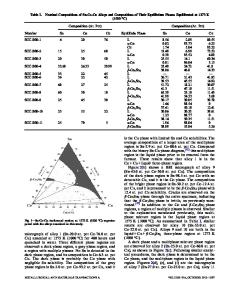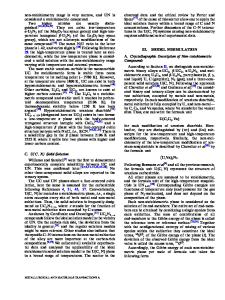Phase equilibria and intermetallic phases in the Ni-Si-Mg ternary system
- PDF / 5,294,567 Bytes
- 14 Pages / 612 x 792 pts (letter) Page_size
- 74 Downloads / 360 Views
ary Ni-Si and Mg-Ni systems are relatively well established.[1] Both of them contain intermetallic phases of scientific and commercial importance. For example, the L12 Ni3Si intermetallic phase, which exists in the Ni-Si system, provides a basis for the development of highly corrosionresistant (particularly in a sulfuric acid environment) intermetallic alloys.[2] In the Mg-Ni binary, the MgNi2 Laves phase is a prototype phase for understanding the overall mechanical behavior of the Laves phases.[3,4] The Mg2Ni compound has recently gained interest in the development of nanostructured hydrogen storage alloys for fuel cells.[5,6] However, the ternary Ni-Si-Mg system was not systematically studied in the past. The only intermetallic phases reported in this system were MgNi6Si6[7] and Mg2SiNi3.[8] Both MgNi6Si6 and Mg2SiNi3 were reported as having a hexagonal structure with lattice parameters a ⫽ 0.4948 nm and c ⫽ 0.3738 nm and a ⫽ 0.50044 nm and c ⫽ 1.10894 nm, respectively. Recently, Pearson’s Handbook Desk Edition[9] (crystallographic data for intermetallic phases) reported structure types of MgNi6Si6 and Mg2SiNi3 as hexagonal Cu7Tb and Fe2Tb type, respectively. The Ni-Si-Mg system is of great interest since some new derivatives of the binary intermetallic compounds discussed previously may exist in the ternary system with attractive but yet unknown properties. In the previous article,[10] the present authors reported a preliminary part of the Ni-Si-Mg phase system covering the Ni- and Si-rich corners. Three ternary intermetallic phases were discovered: (a) the complex cubic (fcc) phase of the Mn23Th6 crystallographic structure type (approximate stoichiometry Mg5Ni17–19Si7), (b) the hexagonal phase Y.K. SONG, Doctoral Candidate, and R.A. VARIN, Professor of Materials Science and Engineering, are with the Department of Mechanical Engineering, University of Waterloo, Waterloo, ON, Canada N2L 3G1. Manuscript submitted January 5, 2000. METALLURGICAL AND MATERIALS TRANSACTIONS A
(approximate stoichiometry MgNi8Si5.5), and (c) the phase with yet unknown crystallographic structure. The present work reports the extension of the phase equilibria studies toward the Mg- and Si-rich sides of the ternary. Some corrections to the previously established phase regions in the Niand Si-rich corners will also be presented. These corrections result from more accurate, fully quantitative energy dispersive spectroscopy (EDS) readings. Here, we use a quantitative analysis method that is different from the previously described method.[10] In the present work, the elemental spectra obtained from intermetallic compounds were employed as the EDS standards instead of the spectra from pure elemental metals employed in the previous work.[10] The approximate stoichiometries for the and phases reported previously[10] will be revised based on the new phase diagram established in the present work. II. EXPERIMENTAL PROCEDURE All the alloys were prepared from pure elements, nickel (99.9 pct) and magnesium (99.8 pct), except silicon that was s
Data Loading...











